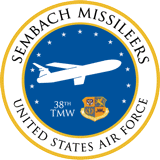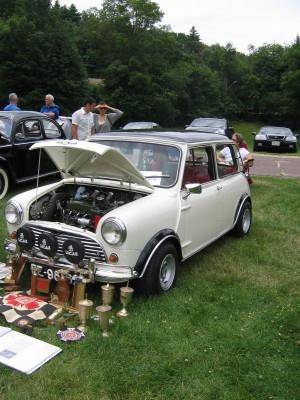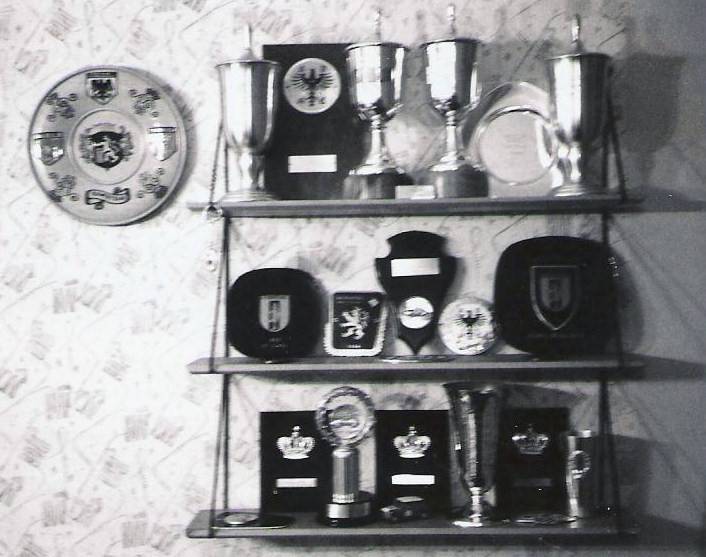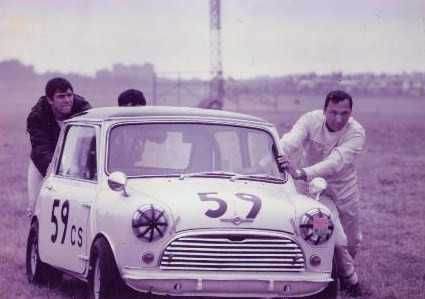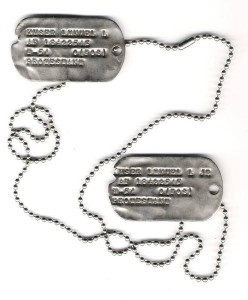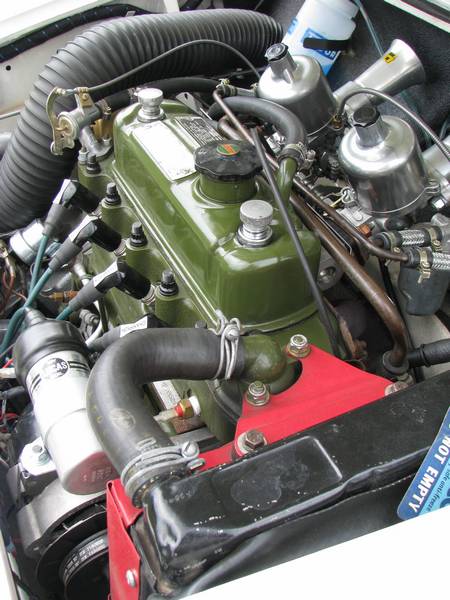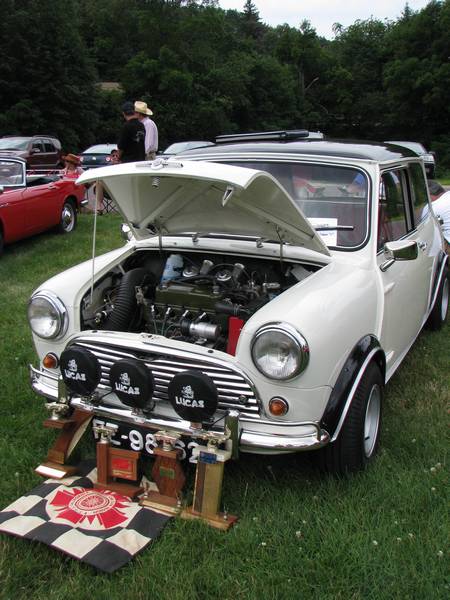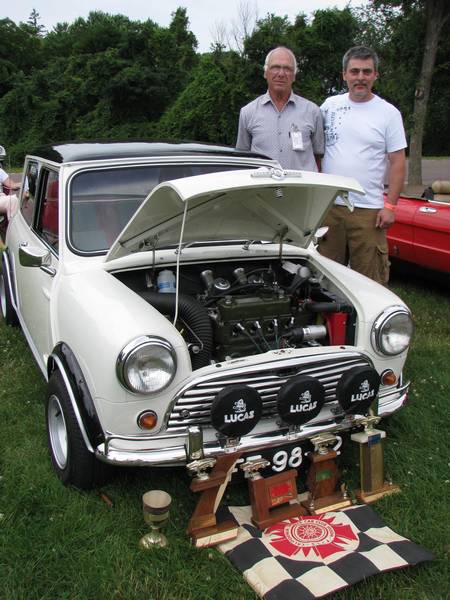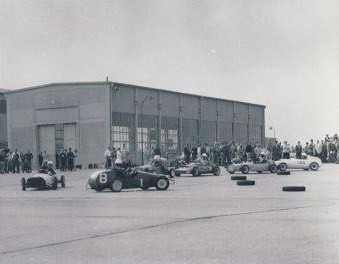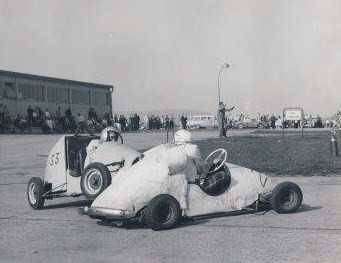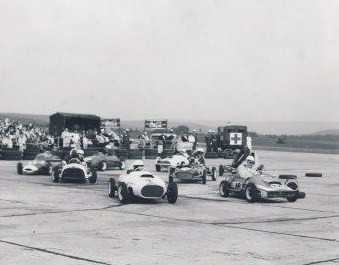By Lee Kyser (887th TMS)
Let me start with the short story:
In June 1964, I purchased a new 1964 Morris Cooper 1275 S (commonly known as a Mini Cooper S). It had been ordered with U.S. specs and, subsequently, I raced it in International events. That got the attention of the Air Force Times. A photo shoot, and story, followed. The coverage was published in the 25 November 1964 issue.
The car was shipped to the States where I raced it in California. In 1969, I sold it to a local radio announcer. That person sold it to another who also raced the car.
Eventually, it was restored to pristine condition and ended up in the hands of Rui Mauricio, a collector from Rhode Island, in 2006.
Russ Reston initiated this website on 27 Jan 08. On 22 Feb, 2008, Russ posted my Air Force Times article. On 23 Feb 08, less than 30 days from the website’s birth, and only 1 day following my posting, Rui found the website.
That posting led to me attending a car show in Massachusetts, as Rui’s guest. It won first place in the car show and I had the pleasure of driving it for approximately 100 miles.
End of short version. For those of you who want all of the details, hang around, and remember you asked for it.
Oh, the ironies the website has revealed — and it is only 6 months old.
Within one week of arriving at Sembach AB, in March, 1961, I was introduced to micro-midget racing, a home-built open wheel racer using an engine with a maximum cubic displacement of 250cc. After racing a friend’s car (Marvin Cleary), I thought it would be a lot of fun to build one, for myself. Clint Everett helped me finance the purchase of a micro-midget that had been partially built. What I bought had a motorcycle engine, but, most micro-midgets were built from the Goggomobil running gear. Though some Goggomobils had larger engines, the ones used for building the little race cars were the ones with the smallest engines since the maximum cubic displacement allowed was 250cc.
GOGGOMOBIL
After paying Clint back (I think), and racing the micro-midget for two seasons, I thought I would “graduate” to something bigger. I had read about the success of the 1963 Mini Cooper 1071S in the Monte Carlo Rally and thought that would be the car for me. So, I checked with the K-Town Opel/Morris dealership (Owner -Gerhard Hubner) and told him I would like to get one. He informed me that there was a newer model with a larger engine and the cost wasn’t much different. I didn’t argue about that, so Herr Hubner ordered a 1275 S for me, with U.S. specifications, since we knew I would probably be taking it back to the States when I rotated, only 8 months down the road.
After the Mini arrived, and was prepped for delivery, I went into the dealership to do the paperwork. The cost was $1825.00. As I went over the contract, something caught my eye that would normally have been meaningless — the LAST FOUR numbers of the car’s VIN matched the LAST FOUR numbers of my AF Serial Number. Okay, that?s nice! How little I knew that that irony would reveal its significance, 44 years later.
Only two weeks after taking delivery, starting on 3 July 1964, I raced the car in the 24 hour Rallye Trifels, placing fourth in class. An Army Major, Bob Feist, was my navigator. During the rally, I won the two-lap race around the Nurburgring (total of 28.6 miles) by 50.3 seconds. Also, I was first in one sprint section, by 11 seconds, and one hill climb, by 17 seconds. Each of those events yielded a first place plaque. (I still have the annotated program for the event)
Following that, on 26 July, I got the Silver in the Wolsfeld Hill Climb, a national event, losing to John Nibert, in a modified Mini, by 2.5 seconds in each of the two runs.
In August, 1964, I entered the International Kurpfalz Rally with a well-experienced navigator, Dr Breuckmann. That resulted in my, one and only, Gold medal — all done with a stock Mini Cooper 1275 S.
There were many more events, prior to departing Deutschland, resulting in a total of 18 awards — mostly from the Ramstein Auto Sports Car Club (RASCALS) events in slaloms, rallies, and drag-racing.
After arriving at Vandenberg AFB, in June 1965, I began racing in the Southern California Sport Car (SCCA) events. The courses included Riverside (RIR), Stardust International Raceway (Las Vegas), Willow Springs, and the Santa Barbara Airport Races. This led to another collection of trophies with many second and third place trophies and one flag for a win in the Saturday race at Santa Barbara.
My final race was at Santa Barbara Airport Races, on Sunday, 29 May, 1969. Sitting 3rd on the starting grid with about 25 cars behind me, the starter dropped the flag and I dropped the clutch — but, the car never moved. That was my most terrifying racing moment — all of the cars behind me trying to avoid my Mini — and me helplessly watching them approach in the rear view mirror. VERY SCARY!
What had happened was the left axle shaft sheared. After all those years of racing, the Mini’s weakest point finally reared its head. Keep in mind, there had been a lot of drag racing which stresses the drive train much more than other types of racing.
The failure of the axle shaft was an indicator to me. I had rebuilt the engine 3 times and the expenses had been within reason. However, I knew that it was just a matter of a very short period of time before I would have to rebuild the transmission. That was going to cost a bundle. Therefore, since I had been wanting to build a D Sports Racer, I felt the time to sell the Mini had arrived.
A local radio announcer, Harold Parham, had been following my exploits. He learned that I was thinking about selling it and he was willing to buy it for $1500, knowing that the tranny might not last very long. I sold it to him — the tranny went south after about 3 months — he rebuilt the tranny, and then sold it to Ray Johnston, after driving it on the street for about a year.
Ray raced the car for many years, in the U.S. and Canada, eventually selling it to John Blixen, who restored the car. Rui Mauricio was searching for a good Mini 1275S that was as original as he could find, with some kind of interesting history to it. He found Blixen’s car and it met his requirements. That sale was finalized 3 years ago, on 12 May 2005.
Click on photo for larger image.
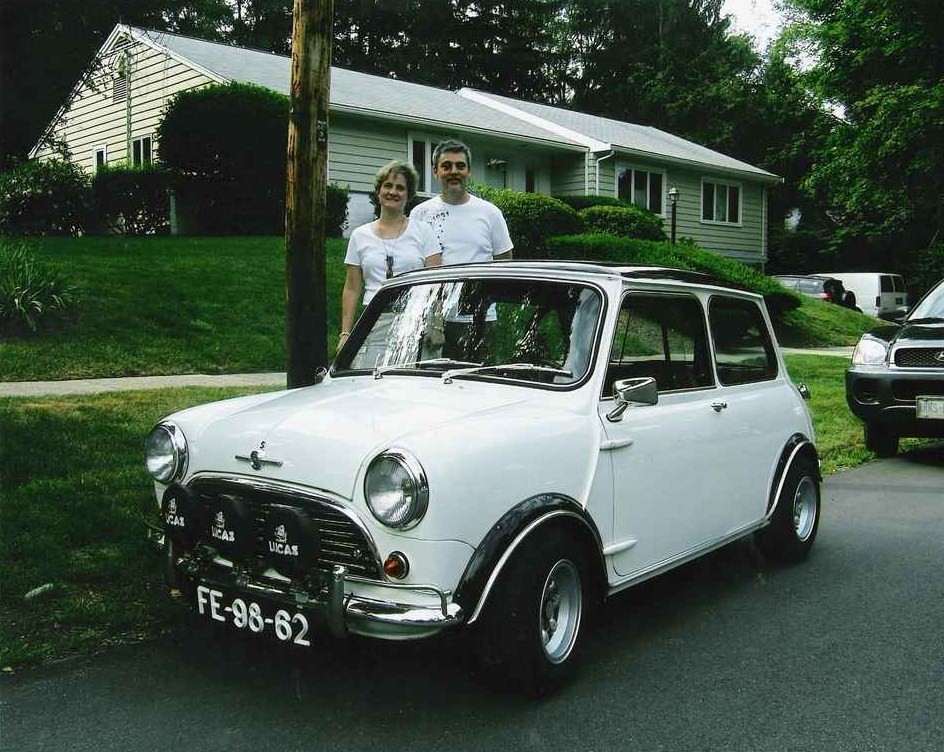
Carmen and Rui Mauricio
New Owners – May 2005
Once purchased, Rui searched for all of the information that he could find on the car. He learned that it was the 43rd Morris Cooper 1275S made, and, that it had been first sold in Germany. Thinking that the instrument cluster should have included a speedo with “klicks”, he bought one, installed it, and sold the MPH cluster. That occurred in the Summer of 2007, barely a year ago.
Meanwhile, on 27 January, 2008, Russ’s website was activated. In his need for inputs, I volunteered my photo and article from the Air Force Times — the one dated 25 November, 1964. It was posted on the website on 22 Feb, 2008.
One day, Rui had the need to take off a license plate. On the back of the license plate, he found a registration form filled out in my name, including my Vandenberg AFB address. He was stunned and rushed to the computer to see if he could find anything on a “Linvel Lee Kyser”. He Googled my name with “Mini Cooper” and the first entry Google had was the “Sembach Sergeant Living ‘Fast’ Life” article from Russ’s website. The date? 23 Feb, 2008, only one day after my posting the AF Times story. I wonder what would have transpired had he tried just 2 days earlier? No story? No connection?
Rui made the 9th entry in the Sembach Missileer website guestbook. Russ made me aware of the entry and Rui’s phone number. I called Rui to inform him, “Yes, I am still with you!”
Rui was convinced, due to the photo and the registration form, that he had my old Mini. I wanted to believe him, but, I wasn’t quite sure. So, I asked him if he would e-mail me with information about the car and to include the VIN number. I knew something, that he didn’t, that would prove it was the right car. Remember the short story? Sure enough, when I got the e-mail, the last four numbers of the VIN matched the last four of my Air Force serial number.
That was the beginning of a wonderful “trip”! I sent some photos to Rui as well as a scan of my old dog tags. Yep! Still have them! Never knew why, until this happened.
Rui is a “Mini” buff and, I might add, an expert on them. He plans on keeping the car for car shows, only. It placed second, last year, in the Gould Microcar/Minicar Show and he had plans to win first place this year. To do so, he needed to get as many photos, and as much history, of the car, that he could. He asked me to attend the car show and promised to let me drive the car, while there, and he would pay for the hotel room. I couldn’t commit, immediately, but I told him I would do everything I could to give him all of the information that he wanted, as well as copies of every photo I have of the car, and any parts that I might have hidden away.
As the months past, I searched for everything that I could find pertaining to the Mini. I knew the trophies were in a box in the garage attic, but, I didn’t remember having anything else. I told Rui that I remembered keeping the original carburetors, after installing the larger racing ones, but I wasn’t sure that I still had them. The same held true for the original bill of sale, but, almost 40 years had gone by. I’m thinking, “Even if I have them, where are they?”.
Finally, I went into the attic and found the trophy box. When I started moving it, another adjacent box became visible revealing the words “1&1/4 inch carbs”. Ta! Da! That made me happy, almost as much as Rui. Never found the bill of sale, though.
As the car show date neared (11 July), I decided to ship the trophies and carbs to Rui, early enough for him to have them prior to my arrival. That was a good move since there was some slight damage to a couple of trophies. That gave Rui time to repair them before the car show.
I arrived at the Providence, RI airport on 10 July and was the house guest of Rui and Carmen Mauricio, that night.
The next day, Rui treated me to a round of golf. Following the golf, Rui drove the Mini, while I drove his family car, with Carmen, to the first gathering for the show. It was held, starting in late afternoon Friday, 11 July, at the home of Charles Gould, the organizer of the car show. Beverages and buffet were supplied by Mr. Gould.
On Saturday morning, all cars were put on display on the lawn at the Lars Anderson Auto Museum in Brookline, Massachusetts. Rui placed the trophies, flag, and picture album that I had given to him, in the front of the car. Carmen and I placed 6 plaques in the rear window.
Minis Engine Compartment
Partial display of trophies
All spectators and participants were given a form for voting on the best cars. Awards were to be given for the top three places in each class. Classes were divided up several different ways, with the Mini Coopers being in their own.
In early afternoon, the awards were announced. Rui’s car won first place in the Mini Cooper class. There were no awards for overall. Had there been, I think Rui’s Mini would have won that, too. It was the only car there with a pictorial account of its past, as well as the only car there with trophies that the car had won during its racing years. We don’t really know if me being there helped, or not. It doesn’t matter, now. What the heck — he WON!
When the announcement was made for Rui and Carmen to come forward to accept the award, I congratulated Rui, and expected him to take Carmen with him. But, they weren’t going to do it that way. Rui insisted that I accompany him. Reluctantly, I conceded. After being given the award, Mr. Gould asked Rui to tell the story of how he was able to find me and get me to the show. Rui wasn’t having any of that and put the mike in MY hand.
So, I told a brief version of what you have just read. The oohs and ahhs subsided and Rui and I returned to the car. We were stopped for photo shoots and congratulations. The photos are now on display on Gould’s MiniCar and MicroCar website.
Following the end of the show, all show cars went on parade, covering about 40 miles. Rui had always insisted that I be the one to parade the car. I didn’t need any encouragement for that. However, I DID have one major concern.
Prior to my flight to Rhode Island, Rui had told me that there was a bearing noise coming from the engine/tranny transfer case. He insisted that the car make the scheduled runs, knowing that there was the possibility that the bearing might totally fail, prior to the end of the tours. With that in mind, he had a tow strap in his family car and would follow the tours, prepared to tow the car home, if necessary. We finished the Saturday run without any increase in the level of whine emanating from the bearing. Sunday would be a different story.
Sunday morning, the run was to travel about 45 miles to a mountain top and return. En route, the bearing noise started to increase in volume. At the third of our four scheduled stops, I told Rui about it. The decision was that, since we only had about 10 more miles to go to the top of the mountain, lets go ahead and try it, since a trailer was already stationed at the top, just for such an event.
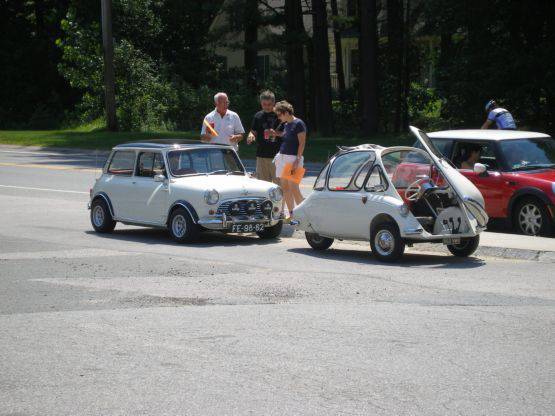
Lee, Rui, and Carmen discussing the bearing whine
I got to within 200 feet of the top when I felt the affected gear jump a few teeth. I stopped and gently tried to pull the grade, in first gear. It skipped teeth, again, so I let it roll back down the hill, and around a corner, to avoid oncoming cars.
I called Rui on the cellphone and he came to the rescue. Rather?than use a trailer to tow the car that day, Rui elected to leave the car at the lavish garage of one of our car enthusiasts, with the intentions of retrieving it, later on in week.
With the Mini parked, I had the chance to meet the owner of the property where the car was sheltered, Don Schoeny. In the massive garage, Don had many collector cars, Porsches, Healey, Fiat, Ferrari, etc. While talking with him, I learned that he had raced at Riverside in the late 60s. Since I had raced the Mini at Riverside in the late 60s, we might very well have been there at the same time.
At one of the RIR races, a memorable event had occurred that might have only been remembered by those who were at Riverside, at the time. So I asked Don, “Were you there when Sam Posey crashed and burned?” He looked at me with a quizzical eye and replied, “Yes!”. That confirmed that he was racing his Austin Healey 3000 at Riverside during the same weekend that I was racing the Mini. We had never met and never really had a chance to. He raced in a different class than me, and at different times.
Sam Posey wasn’t injured in the crash. Someone spun out in front of him and Posey had no way to avoid broad-siding the car. The spinning car went up in flames and only THAT driver suffered any injuries. I don’t remember the degree of the injuries — neither did Don.
Following the tour of Don’s collection, we went to another garage, about 10 miles away, belonging to Charles Gould. I wasn’t prepared for what I saw! There must have been 40-50 cars crammed together. From XKE Jaguars, a Porsche Spyder (remember James Dean?) down to cars the size of a couch. Included were 6 or 7 Goggomobils. Wow! I never knew they had ever been exported to the U.S!
One of the Goggomobils was the same model, and color, of the Goggomobil I used for transportation in Germany, following the shipment of the Mini. Yes, the same type of car that we used to make the micro-midgets. What a surprise!
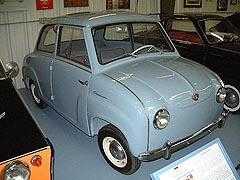
1958 Goggomobil
(about 2 feet shorter than a Mini)
Since then, I have discussed Goggomobils with Charles. Even though he is a big collector of Goggomobils, and knows most of their history, he had never heard of them being used to make race cars.
So, upon returning home, I scanned 7 photos of the micro-midgets to him. Now HE is anxious for me to drive a Goggomobil at the 2009 car show.
Hmmm? I wonder how this will play out, next July.
Rui has the Mini back home now. He has a spare engine and transmission he can put in the car, while repairing the original one. Before the year is out, he hopes to have the car back in its original configuration, which will include the original carburetors. However, there is one more major task ahead! Remember me mentioning Rui replacing the MPH speedometer cluster with one that reads in kilometers? After learning the original cluster was in MPH, Rui contacted the buyer and tried to buy it back. No luck! He wouldn’t sell! The proper one is hard to come by and expensive, once found. Reconverting might take some time.
One last irony! Often, car events have an award for the worst mishap. In this case, the only other mishap was someone running out of gas. Since Charles had two plaques reserved for catastrophic failures, he awarded one to the owner and one to the driver.
Yep, that Mini won me another “trophy”! (Read the inscription)
STRANGE HOW THAT NUMBER 13 COMES INTO PLAY, SOMETIMES.
IN ADDITION TO THIS BEING THE THIRTEENTH ANNUAL EVENT, IT ENDED ON SUNDAY, 13 JULY, 2008.
